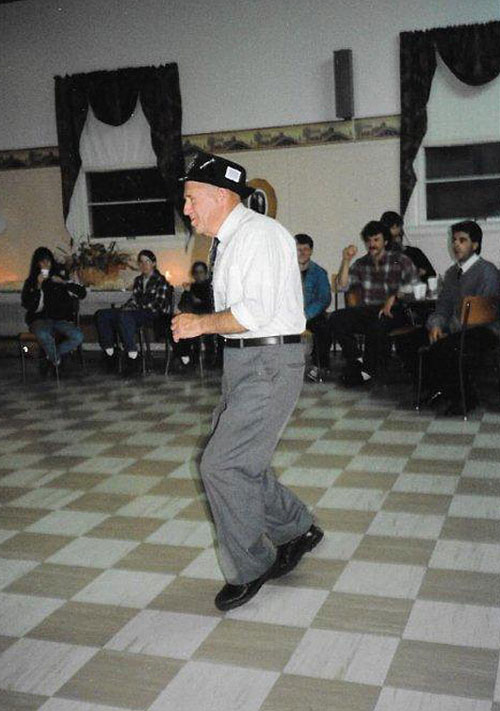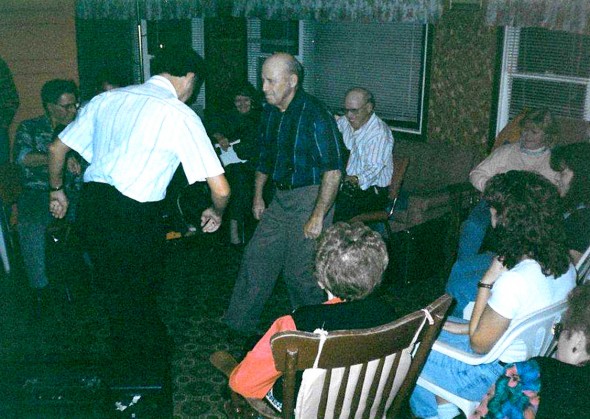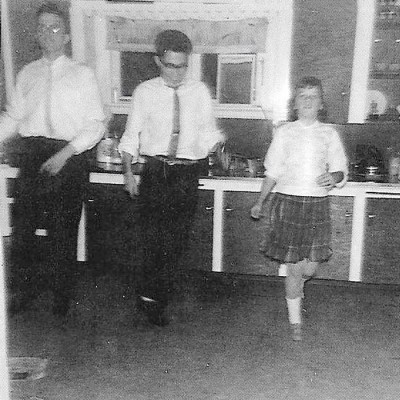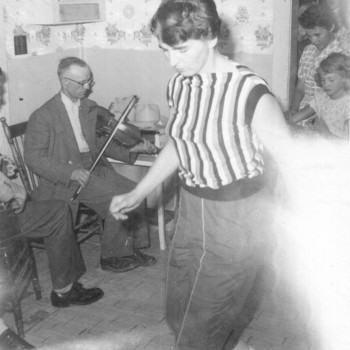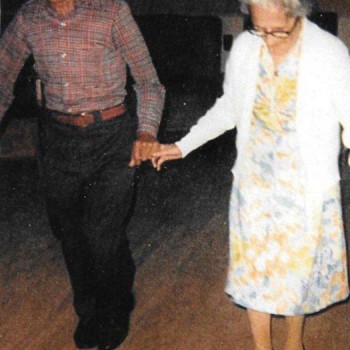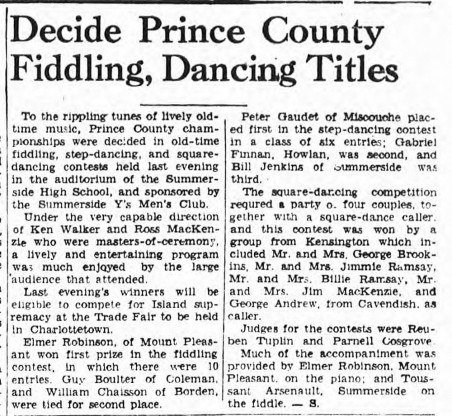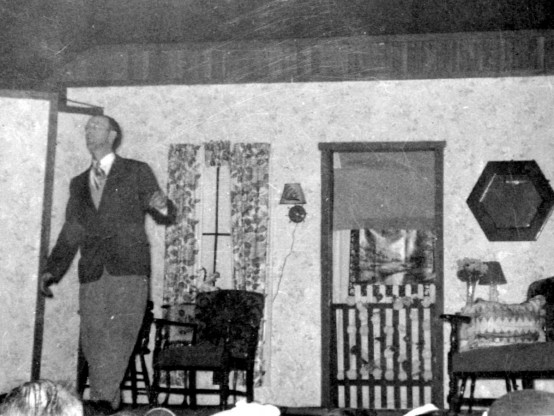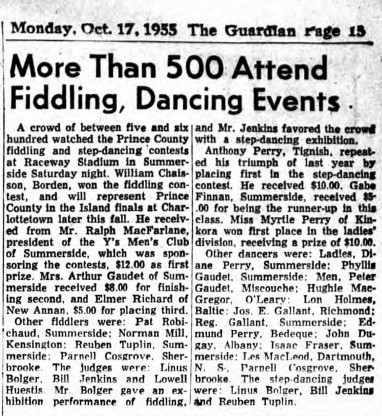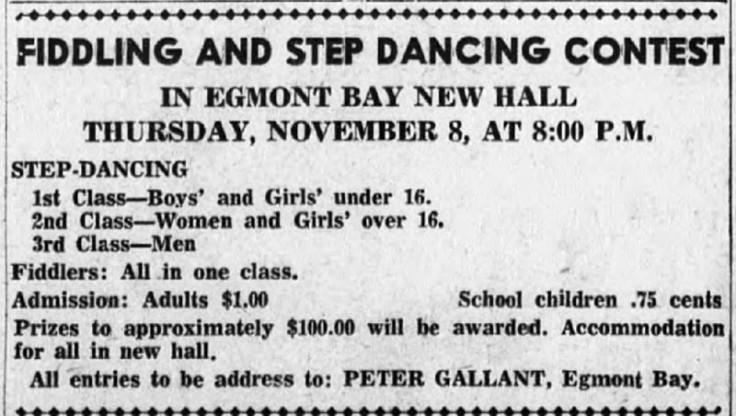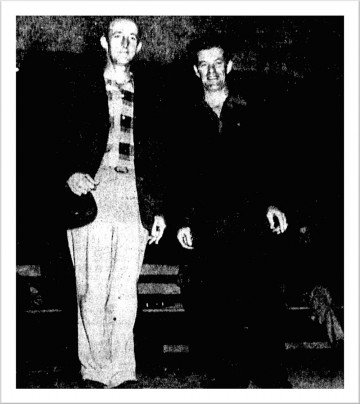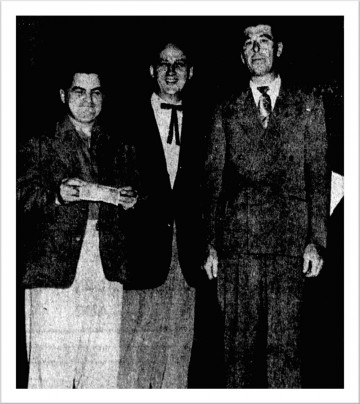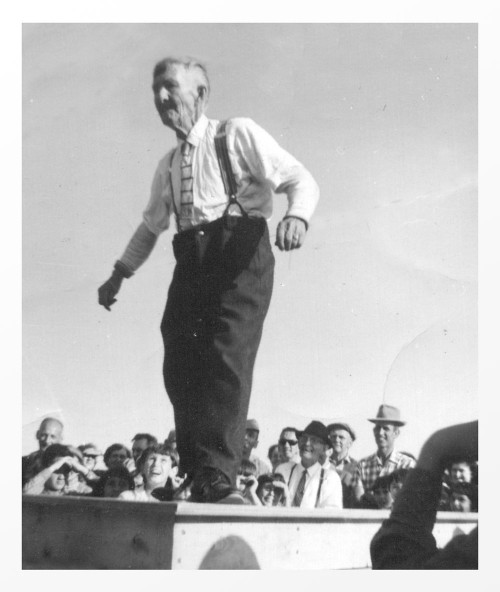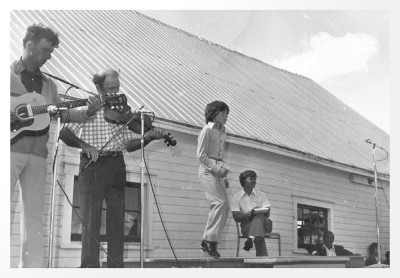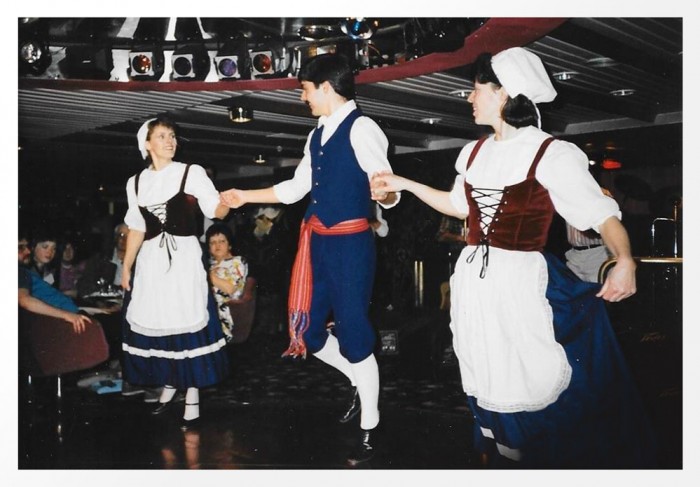Step dancing traditions have a long history in Acadian and Celtic communities across P.E.I., with notable similarities in style and steps to neighbouring Cape Breton Island. Step dancing refers to a style of percussive dance featuring fast-paced, intricate footwork that is performed to traditional fiddle, accordion, harmonica, or sung music. Compared to other step dancing traditions across Canada, especially the Ontario Valley or Québécois styles, P.E.I. step dancing is performed with loose arms and a relaxed body position, and the steps are executed close to the floor.
STEP DANCING
Learn more about Acadian Step Dancing
The “Old Style”
Dancers and musicians today often reminisce about the “old style” of step dancing that was practised before the revival of traditional dance that occurred in the 1970s.
Shifting Contexts
Modernization and the rise of new technologies across P.E.I. resulted in major changes to social life and entertainment by the mid-1950s.
Contests
The Charlottetown Fiddle Contest of 1926 was billed as “P.E.I.’s First Fiddle Contest,” but local fiddle and step dancing contests were common in communities across the island by that time.
The Shuffle
The term “shuffle” (in French, un frotté) refers to a dance movement that produces a specific sound when the ball of the foot is pushed in a forward-to-backward motion, low to the floor.
1980s to Present
In the mid-1970s, several members of Les Danseurs Evangéline began to teach dancing in the Evangeline area. Formal transmission of dance steps increased in the 1980s.
Danse assise
Les Danseurs Evangéline brought danse assise into their repertoire when there were too few male dancers in the troupe to form male/female partners in set dances.

THE ``OLD STYLE``
Step dancing, like the practice of podorhythmie (seated, percussive foot-tapping) is considered an important part of the region’s musical tradition. Dancers and musicians today often reminisce about the “old style” of step dancing that was practiced before the revival of traditional dance that occurred in the 1970s. This earlier style was characterised by a spontaneous, improvised style of dancing that would have been performed between square dance sets– and sometimes as part of square sets – at informal house parties and other local events. This older style is usually described with phrases like “from the heart” and “free,” in contrast to what Acadian step dancer Colette Aucoin calls a formal, more choreographed “gigue de spectacle” (Aucoin, 2008). As Marie Livingstone explains, “everyone back then had a unique way of dancing. They just danced what they felt. No one danced the same” (Livingstone 2012).
Older tradition-bearers note that there are few dancers today wo have retained this earlier style. Helen Bergeron (née Arsenault), a member of the popular Acadian group Barachois (1995-2003) and daughter of the late P.E.I. fiddler Eddy Arsenault (1921-2014), describes the earlier style as being similar to clogging and the Irish sean-nos step dancing style in that Acadian step dancing is performed with the feet kept close to the floor and a strong rhythmic drive. In the video below, Helen describes how she learned to dance:
Edna Hashie (Arsenault) describes how she learned to dance
and shares a rather unique tip for practicing:
My grandfather – my mother’s father, Emanuel, his name was – was a very good dancer. And light. Light on his feet. Since my grandfather was a dancer, my mother and her sisters were dancing also and then it went down the generations. [They learned] from one to the other. They never had any lessons. Just watching and wanting to learn how they were doing it. That’s how I learned. I had a cousin who was dancing already…and she was the one who showed me how to make steps. And then…well, we didn’t have a bathroom in the house. We had to go outside and they called that an outhouse. And that’s where I’d practice! I don’t think I wanted to dance in front of anybody at first, so that’s where I practiced. The only private spot with wooden floors.
Edna Hashie, 2013
VIDEO 2 (07:45) – Claudette and Yvonne talk about Acadian dance style
Although many women learned to dance from watching older family members, it was the men who most frequently took to the floor at house parties and in competitions. Women were more inclined to dance off-stage, sometimes offering a step or two at house parties when the mood struck them. Step dancer Rosella (Caissie) Arsenault recalls that men and women often had different styles of dancing, and everyone had their own favourite steps.
Éloi Arsenault describes the differences between male and female dancers:
VIDEO (Eloi, 6:08-8:15?) – talking about differences

EVOLVING STYLES, SHIFTING CONTEXTS
Modernization and the rise of new technologies across Prince Edward Island resulted in major changes to social life and entertainment by the mid-1950s. By the 1970s, the older, improvised “kitchen” style of step dancing that was once prominent in P.E.I.’s Acadian communities had been largely supplanted by a choreographed style of step dancing influenced by that incorporated standardized steps from formal teaching, the emergence of local dance troupes, and popular dance forms.
In the Evangeline region, dancers Rosella (Caissie) Arsenault and Marcella (Gallant) Whillans were the first young dancers to adopt a more standardized “shuffle” step and use clickers on their dance shoes. They were inspired by dancers on Don Messer’s Jubilee TV show and especially the stylised “shuffle” and dance shoes of Charlottetown dancer Marlene Weatherbie-Goodine. In 1957, at the age of 14, Rosella and Marcella performed at the Summerside Lobster Festival with jingle taps (clickers) on their dance shoes for the first time.
Rose describes learning and practicing steps as a young girl:
My father played mouth organ, and we would dance. I would practice in front of the TV or mirror in the living room so that I could see what my feet were doing. I had to make sure both feet were doing the same thing – that was important for competitions.
Rosella Arsenault, 2015
Step dancing gradually shifted to more formal performance contexts, including festivals, shows, and competitions.
Image: [Isabelle-Helen-IrishNight-1960s].
Isabelle (Gallant) Owen (left) and Helen (Arsenault) Bergeron from Saint-Chrysostome, Prince Edward Island audition for an “Irish Night” at the Summerside Lobster Carnival in the 1960s.

FIDDLE AND STEP DANCING
CONTESTS
The Charlottetown Fiddle Contest of 1926 was billed as “P.E.I.’s First Fiddle Contest,” but local fiddle and step dancing contests were common in communities across the island by that time. It was the first province-wide contest, however. The event featured fiddle and step dancing competitions and ended with set dancing. (For more information on this contest, see James Hornby’s 1979 article in The Island Magazine)
Helen Bergeron, daughter of renowned fiddler Eddy Arsenault, describes going to contests in the 1950s and 1960s:
… at that time there were a lot of fiddling and step dancing contests. I’m sure that during the season there was one a week, if not more. And dad would go [to contests all over P.E.I.], and we would always go with Dad and participate in the contests.
Helen Bergeron, 2008
An article about the Prince County contests in 1952 lists Peter Gaudet of Miscouche as the first-place winner of the step dancing contest. Interestingly, the article also mentions square-dancing competitions in which four-couple groups competed for the title. The music for the contests was provided by the popular dance fiddler Toussaint Arsenault of Summerside and Elmer Robinson of Mount Pleasant on piano (who also won first place in the fiddle competition!).
Other articles describe the fiddle and dance performances of contest judges at the beginning of the contests to warm up the audience (see above)
Articles in The Guardian newspaper published on October 4, 1954, picture the winners of Prince County’s Old-Time Fiddling and Step-Dancing Contest held in Summerside. Pictured in the first photograph are (left to right) Mary Eva Gallant (Summerside), Norma Shea (Tignish), and Mrs. Fred Matthews (Summerside), who took part in the step dancing contest, while Mrs. Arthur Gaudet of Summerside (far right) was one of ten women who competed in the old time fiddling competitions.
The second photograph shows first-place step dancing winner Tony Perry of Tignish and Peter Gaudet of Miscouche, who won second-place. Both men represented Prince County for the P.E.I. Championship in Charlottetown.
Finally in the third photograph, fiddling masters Linus Bolger (right) and Toussaint Arsenault (left) of Summerside are pictured with the Master of Ceremonies Al Nicholson (centre) following their first place win.
L'EXPOSITION AGRICOLE ET LE
FESTIVAL ACADIEN DE LA RÉGION ÉVANGÉLINE
Founded in 1903, the Egmont Bay and Mont-Carmel Agricultural Fair is one of the oldest agricultural fairs on Prince Edward Island. In 1965, the Fair included one hour of fiddling and step dancing performances, as shown in this photo of Albénie Arsenault (1881-1979) of Saint-Gilbert:
In 1971, the Acadian Festival was added to the exhibition to promote Acadian culture. The programming expanded to include a parade, a mass on the water, a variety of contests, a lobster supper, and music and dance performances. Fiddle and step dancing contests were integrated into the program in 1974.
Although the contests were well attended and enjoyed by performers and spectators, growing frustration and acrimony eventually led to a near absence of fiddle (and to a lesser extent dance) contests on the Island by the end of the 1970s. The Acadian Festival retained its fiddle and step dancing contest format until 1978 (fiddle) and 1984 (step dancing).
JUDGING AT THE CONTESTS
Step dancing was adjudicated on several criteria, including the symmetry of steps (same on both feet), timing, and energy. Sisters Claudette and Yvonne talk about the “liveliness” associated with great dancing:
Success in the dance competitions brought local recognition and, in some cases, winning local contests created opportunities for touring more broadly. Step dancing champion Floyd LeClair of St. Peter and St. Paul (Tignish) was a popular young male step dancer and was successful in numerous local competitions, winning the Island Stepdancing Championship in 1989.
Following this success, Floyd joined Experience Canada on their “Spirit of the Nation” (1992) tour as the representative of Acadian culture, and later joined Bernadette LeBlanc and Helen Bergeron as dancers on a cruise ship that traveled to New York City, Boston and Philadelphia.
Bernadette-Floyd-Helen on cruise ship. (Coll. Helen Bergeron)

THE 'SHUFFLE'
Many contemporary step dancers perform steps that replicate the rhythmic line of the fiddle tune and at the same time complement the “toe-toe-heel” rhythm of the seated foot tapping (Ouellette 2005, 25). The term “shuffle” (in French, un frotté) refers to a dance movement that produces a specific sound when the ball of the foot is pushed in a forward-to-backward motion, low to the floor, which Acadian dancer and pianist Mylène Ouellette describes as a “brushing movement of the feet” (Ouellette 2005, 16). This shuffle is generally followed by a tap movement with the same foot, and then the shuffle-and-step pattern is repeated starting on the opposite foot. This shuffle-and-step is the starting point for most dance steps and varied rhythmic patterns.
See Zélie-Anne Poirier step dancing @ 24:22 in the below National Film Board video.

STYLES OF ACADIAN STEP
DANCING SINCE THE 1980s
“La gigue est encore en vie….” (Sylvie Toupin, 2015)
Formal transmission
In the mid-1970s, following their local and international success, several members of Les Danseurs Evangéline began to teach dancing in the Evangeline area. In the area of Tignish, Elaine Wedge was an established dancer and teacher. Formal transmission of dance steps increased in the 1980s. Contemporary Acadian step dance routines, as in most step dancing traditions across Canada, are generally organized in a series of steps (alternating between starting on the right or left foot), each lasting between eight and sixteen beats of music, before a new step is introduced.
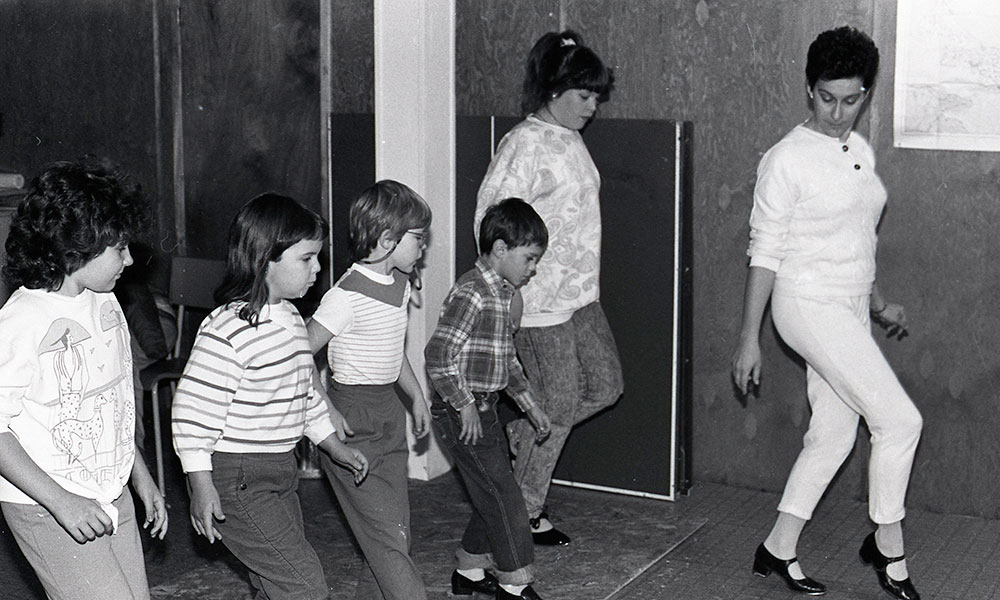


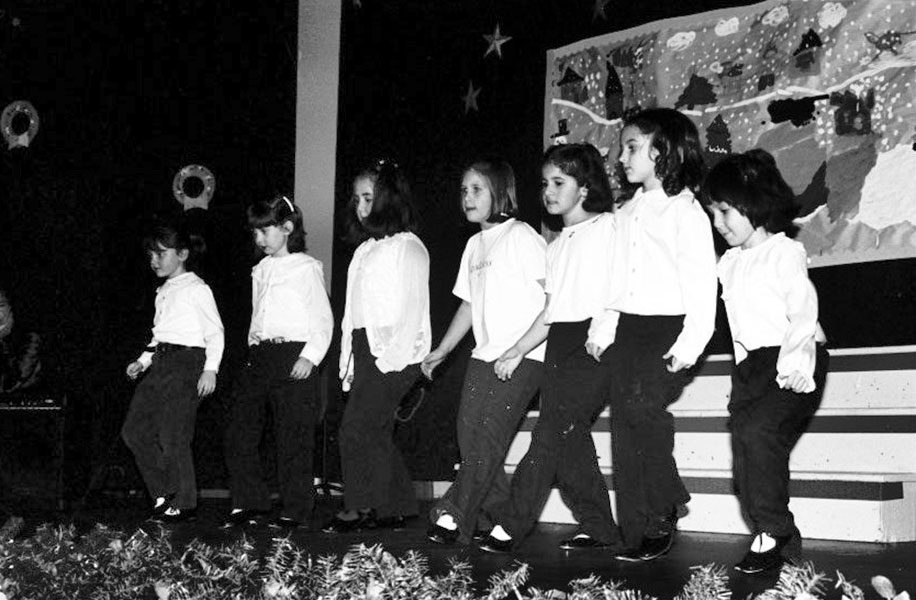
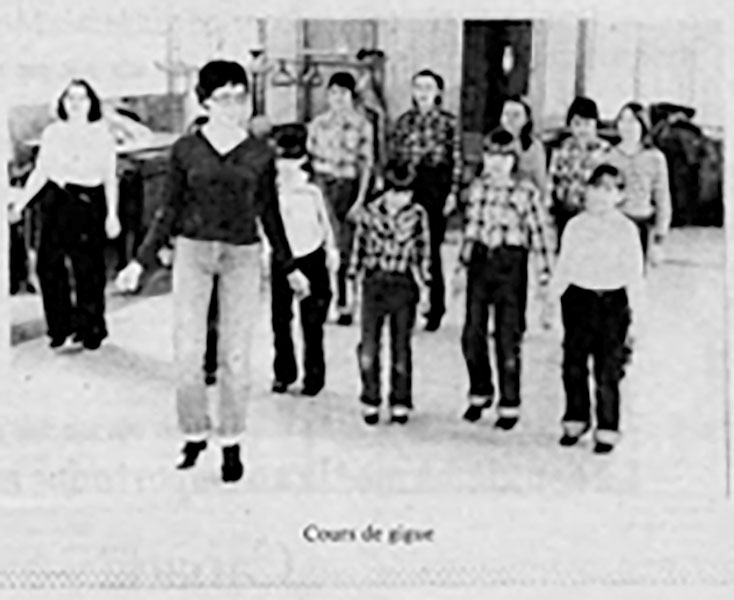
Yvonne Tuplin describes the challenges of the modern style of step dancing styles compared to the step dancing she recalls from her youth:
In the last few years, my sister Claudette and I started step dancing lessons with Marie à Polycarpe. Some of the steps are similar but most are different than we are used to…The difference is two or three steps are combined into one; much more complicated than when I was young and I don’t have the memory to always remember what comes next.
Yvonne (Arsenault) Tuplin, 2013
On the balls of the feet
Dancer and choreographer Sylvie Toupin relocated from Montréal to the Island in 1981, and introduced new influences to the local dance scene. The style of dancing changed to a shuffle performed on the balls of the feet, which coincided with a shift to a preference for dance shoes with higher (2-inch) heels, more akin to ballroom dance shoes.
VIDEO clip: Sylvie interview

DANSE ASSISE
Sylvie Toupin choreographed performances for many local dance troupes, including Les Danseurs Evangéline, and mentored numerous younger troupes. Another lasting contribution has been Sylvie’s introduction of the Québécois tradition of danse assise, or “seated step dancing,” to the repertoire of dance troupes in the region. Danse assise consists of elaborate variations on the basic “toe-toe-heel” foot-tapping pattern, combined with modified steps borrowed from step dancing. Seated in a line of armless chairs, five or six dancers perform the “shuffle” step in combination with “cross-steps,” “walking steps,” and heel taps, to name just a few, both in unison and by “passing” steps between dancers to create a kind of rhythmic conversation.
Les Danseurs Evangéline brought danse assise into their repertoire when there were too few male dancers in the troupe to form male/female partners in set dances. The practice was subsequently adopted by groups such as Barachois, Les Tapageuses, Vishtèn, and others, some of whom have combined these traditional Acadian forms of percussive dance with international influences, such as South African gumboot (Isicathulo) dancing.




